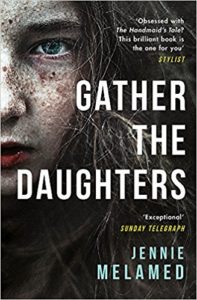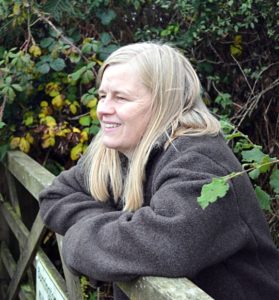
Guest Review by Nina Allan
 On an unnamed island somewhere off the US coast, the Wanderers preside over a closed society founded by the Ancestors, ten families that first came to the island in order to escape a catastrophe on the mainland. Through the passage of generations, their company has grown, their society evolved to the extent that they are mainly self sufficient, able to survive without modern technology using pre-industrial farming and manufacturing techniques. There is a school, there is a church, there are traditions. Key to the functioning of the entire community is the subjugation of women.
On an unnamed island somewhere off the US coast, the Wanderers preside over a closed society founded by the Ancestors, ten families that first came to the island in order to escape a catastrophe on the mainland. Through the passage of generations, their company has grown, their society evolved to the extent that they are mainly self sufficient, able to survive without modern technology using pre-industrial farming and manufacturing techniques. There is a school, there is a church, there are traditions. Key to the functioning of the entire community is the subjugation of women.
The core function of women on the island is to be wives and mothers. In order that the population does not become too large for the resources available, the number of children born to each family must be restricted. A woman can have two children only. Her job then is to take care of those children until they reach puberty, the ‘summer of fruition’, at which point they are required to pair off and start families of their own. Once the children have flown the nest, the ‘orphaned’ parents are allowed to stay on in their home until such a time as the man is still able to perform in whichever field of work he has been born into. Once the man begins to fail physically – usually sometime during the decade between forty and fifty – the couple will drink their ‘final draught’ and their bodies be used to fertilise the fields.
We follow the stories of four young women as they come of age. Amanda is married to Andrew, and heavily pregnant. When the island’s wise woman predicts that the baby she is carrying is a girl, Amanda finds herself increasingly desperate to get free of the cycles of behaviour preordained for her by the island’s elders. As the daughter of one of the Wanderers, Vanessa enjoys a privileged access to books and information, but as a female she is just as restricted as Amanda in who she can be and what she can hope for. Caitlin is something of an outcast. She was not born on the island, but came to the community with her parents as an infant. She remembers nothing of her life on the mainland, only that the stories told about the conditions there do not quite ring true. The eldest of the four at nineteen, Janey has starved herself almost to death in order to delay menstruation and thus avoid the irrevocable loss of independence that marriage will bring. She is dauntlessly protective of her younger sister, Mary, a generous-hearted, beautiful girl many men have their eye on.
And here’s the twist: in order to prevent their wives from having too many children, it is accepted that fathers will have sex with their prepubescent daughters, right up until their summer of fruition, when the girl will become the sexual property of their new husband. The daughters accept this as normal, the kind of behaviour that no one talks about openly but everybody knows about.
Until they come of age, all children spend their summers running wild on the island’s beaches and in the forests, surviving off the food left out for them as per the custom, forming rivalries and cementing friendships, throwing off the pressures of school, the thought of adult responsibilities to come. It is towards the end of summer that Caitlin sees the Wanderers dragging Amanda’s dead body from the sea. The official account of this tragedy conflicts strongly with what Caitlin has seen, with what she very soon imparts to the other daughters. In the manner of so many dystopian narratives, a rebellion is soon underway. Will the power of the men be broken? Will the women begin to understand the true nature of their predicament?
I think most science fiction readers would agree that, small tweaks and turns aside, the narrative arc of Gather the Daughters feels very familiar. The closest analogue is probably with John Wyndham’s The Chrysalids, published more than half a century ago in 1955. The Chrysalids takes place not on an island but in the Canadian region of Labrador, the only part of North America to have escaped the nuclear apocalypse that engulfed the planet generations before. As in Gather the Daughters, a new agrarian society has evolved. Travel beyond the safe zone is strictly prohibited, and the community’s religious elders exercise control according to a doctrine of extreme Puritanism combined with a programme of preventative eugenics: all ‘mutants’ are rooted out and either destroyed at birth or sent to the Fringes, a contaminated zone inhabited by society’s outcasts, most of whom are mutants themselves.
The Chrysalids is a classic work of post-catastrophe science fiction, told through the medium of a coming-of-age story. Predictably rebellious teenagers bring about a revolution that is both personal and political through the discovery of telepathic powers that would have them ostracised as mutants were they to become known to the wider community. By developing their powers in secret, the teenagers eventually make contact with a more radically evolved community of survivors on the other side of the world. The limited worldview handed down by the elders has been proved false, the idea of mutants as dangerous to progress has been overturned. By the time the novel closes, it is clear to us as readers that the world has moved on.
Throughout the early chapters of Gather the Daughters, it would appear that we have embarked on a similar journey. It is not long before we start to notice differences, however. The ‘Tribulation’ that destroyed civilization in The Chrysalids really took place as described within the narrative – those rare explorers who venture south to the ‘Badlands’ return with tales of a blasted, nightmare landscape, incapable of sustaining life. Whatever the rights and wrongs of it, the policy of exterminating mutants has evolved as a direct response to a real situation – presumably a fatal proliferation of genetic mutations caused by nuclear contamination. In Gather the Daughters, we quickly begin to suspect that the ‘wastelands’ described by the elders do not exist. The Wanderers make regular trips to the mainland by ferry, returning to the island with additional provisions, books, clothing, occasionally medicines (which are forbidden under island law), even more occasionally new settlers who wish to make a home with the community. These new recruits are expressly forbidden from speaking of the life they left behind and it is easy to see why. What is not so easy to understand is how such a situation might realistically be expected to persist when the outside world, with its rule of law and modern methods of communication, seems to be alive and well just a couple of nautical miles away.
The world of The Chrysalids feels convincing, governed by rules that seem draconian by our own standards, yet possessed nonetheless of a readily identifiable internal logic. The same cannot be said of the established codes of conduct in Gather the Daughters. Melamed, who works as a psychiatric nurse, has stated that her purpose in writing the novel was to explore some of the issues around abuse, and in particular to look at how ‘something our society might consider abhorrent would be considered normal, and even necessary, in another society’. An interesting idea, and one that could definitely make for thought-provoking science fiction. Unfortunately the illogic that governs the action of Gather the Daughters rapidly causes the narrative to lose momentum. The questions are myriad, and they will not stop coming: why would the wives connive in the abuse of their daughters, when more acceptable methods of birth control are available and known to all? Why the panic over a few extra babies when so many children seem to be ‘defective’ or stillborn anyway? Why would women have consented to go to the island in the first place when there was no actual apocalypse to force them to flee there?
The latter third of the novel is perhaps the least satisfactory as the teenagers’ nascent revolution is suddenly stymied by a deus ex machina, an outbreak of a deadly virus that kills a third of the island’s population within weeks of striking. The disease appears to arrive literally from nowhere, with no other narrative purpose than to kill off the drama’s active participants, thus re-establishing the old order with no questions answered. The novel’s conclusion sees Vanessa escaping from the island with the rest of her family – her Wanderer father decides they must leave, not because he has belatedly come to understand the crimes being committed within the community but because the other elders have threatened to burn his books!
I must stress that there is nothing wrong with Melamed’s writing. Her use of the present tense makes the narrative immediate and accessible, her evocation of life on the island – the simple homesteads, the preparation of food, the changeable climate, the forest and beaches, even the mosquitoes – is pleasingly tactile. Her point of view characters are drawn with tenderness and skill – Amanda and Janey especially have some memorable passages, and come across convincingly as individuals. There is something almost dream-like about the island and perhaps we should also wonder if the richness of the language, the poetry of it, is entirely appropriate to the brutal subject matter. A fable-like stasis hangs over this narrative that makes us doubt its veracity.
The greatest problem for me with Gather the Daughters is that no one is allowed to behave or think or speak like an adult. (We have only to think of the depth of field achieved by Margaret Atwood in her characterisation of The Handmaid’s Tale to see how Melamed’s novel is deficient in this regard.) A narrative that depends on compliance will inevitably run out of steam, as this one does. History has proved to us time and again that holding down a dictatorship is difficult work – sooner rather than later the peasants begin to uncover the injustices and deceptions perpetrated against them, and start to revolt. You have to kill a lot of people to keep these systems going, and even so your days as a despot are numbered from the beginning. On the island, the only reason nothing has come unstuck for the Wanderers so far is because everyone else in the community insists on behaving like characters in a YA dystopia.
As a reading experience, Gather the Daughters is smooth and even pleasant. There is a lot of repetition, but Melamed is a competent writer, and her engaging prose style means you don’t notice the lack of direction as much as you otherwise might. There are readers – plenty of them – who will enjoy this book for its sense of place, for the bravery and camaraderie of its young protagonists. The question we must ask ourselves in the context of the Clarke Award though is this: what does this novel say about science fiction in 2018, and does it deserve its place on the Clarke Award shortlist?
When I first came across the synopsis of Gather the Daughters sometime last year, my instinct was to pass, not because I thought I wouldn’t enjoy the book, but because I didn’t think I’d be experiencing anything new. As it turns out, my instincts were right. The subject matter is clearly intended to be edgy and disturbing, yet set aside the incest and Gather the Daughters reads like any other YA dystopia – better written than many, certainly, but in terms of approach you won’t find anything here to challenge or even surprise you. In terms of its use of speculative materials, although the novel has a science fictional sensibility there is no actual science fiction in it, unless you consider a story of life inside a religious cult to be science fiction.
If you are looking to the Clarke Award shortlist to provide an overview of different approaches to the genre then it could be argued that Gather the Daughters fits right in – these kinds of stories are in vogue right now, there is a strong focus on female characters, and the writing is confident, enjoyable to read and with a generous streak of individuality. If, like me, you would prefer to see the Clarke Award rewarding science fiction that pushes the boundaries and makes us think more deeply about science fiction as a radical literature, you may well feel mystified as to why the judges chose to include this particular novel in their final line-up.
*
 Nina Allan is a writer and critic. Her debut novel The Race was a finalist for the British Science Fiction Award, the John W. Campbell Memorial Award and the Kitschies Red Tentacle. Her second novel The Rift wase published by Titan Books in July 2017. She enjoys arguing about books in general and science fiction literature in particular, and makes these arguments public from time to time at her blog, The Spider’s House. Nina lives and works in Rothesay, on the Isle of Bute.
Nina Allan is a writer and critic. Her debut novel The Race was a finalist for the British Science Fiction Award, the John W. Campbell Memorial Award and the Kitschies Red Tentacle. Her second novel The Rift wase published by Titan Books in July 2017. She enjoys arguing about books in general and science fiction literature in particular, and makes these arguments public from time to time at her blog, The Spider’s House. Nina lives and works in Rothesay, on the Isle of Bute.

